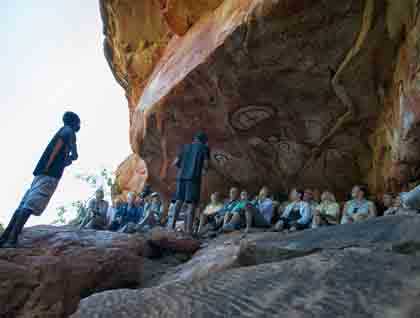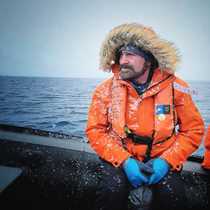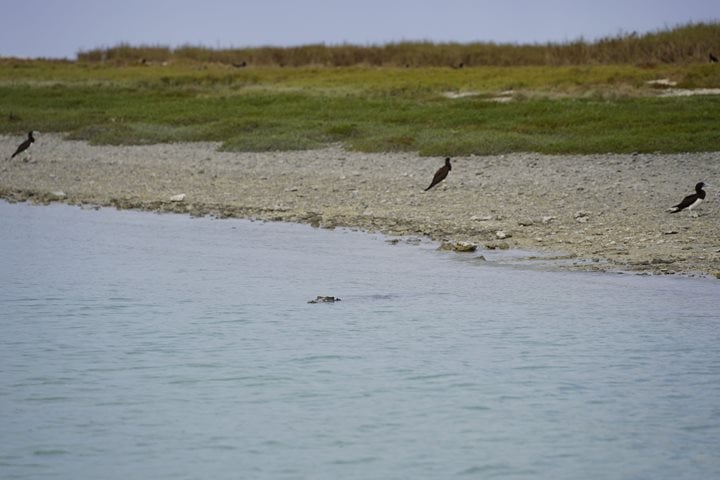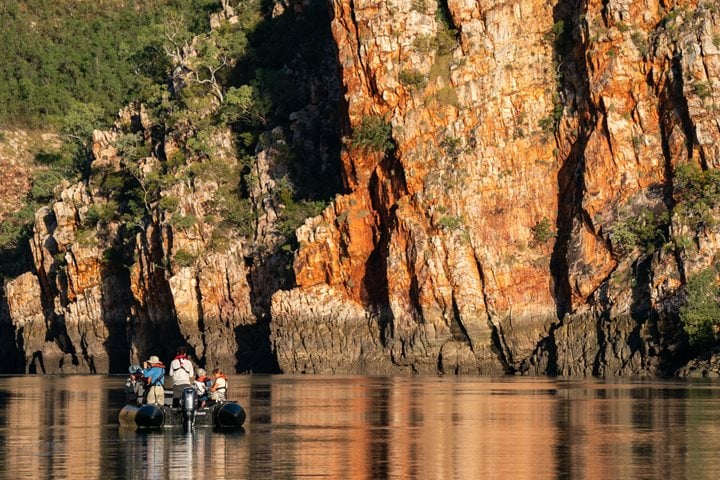Following a stunning day in Yampi Sound, the National Geographic Orion heads almost due east along the Kimberley coast to arrive this morning at Raft Point. This sea country belongs to the Worrorra People who lived here for thousands of years and whose living culture remains today.
As we transfer ashore we are met by the imposing sandstone figure of Raft Point Bluff while passing by its offshore sentinel, Steep Island. Ashore at the bluff we are met by a Worrorra welcoming party from their outstation at Freshwater Cove. Robin gives us a welcome to this country after which a senior Worrorra man, Kenny Woolagoodja, leads the party up a short but steep climb to the base of the bluff to tell the traditional stories behind some of the most impressive examples of Wandjina art in the Kimberley.
The art exists in an overhanging rock gallery that would have provided shelter to the Worrorra as well as a commanding outlook over their country. The spirit figures and important depictions speak of a time immemorial and appear almost as ancient as the sandstone rock on which it is painted. In part, the significance of this site links people and place and we welcome the invitation to take memorable photos.
During lunch National Geographic Orion makes a short trek northwest to Montgomery Reef. A truly amazing spectacle at any time, today we are spoilt as we witness Montgomery Reef in all its glory at the peak of a full-moon spring tide as the water cascades off the top of the reef and the lagoon within. It is not only the size of the reef that is impressive (around 400 square kilometres (154 square miles)) but the fact that it has survived as a relic of times when sea levels were higher than they are now allowing the reef to appear to have grown out of the water. These combinations means the reef ecosystem supports an incredible diversity of life from birds, sharks, rays, and marine turtles.
As we take the Zodiacs and venture into a channel that has been carved into the reef by the relentless tides and cascading waters, we come to terms with the feeding opportunities that this massive movement presents to the birds that are regular ebb tide visitors. Countless eastern reef egrets along with pied oyster catchers, curlews, and intermediate egrets ply their trade as we lose track of how many green marine turtles pop their heads up for a breath.
As the sun fades and the tide heads towards the bottom we head out of the channel. But today’s expedition is not over yet. On an exposed sandbar the National Geographic Orion hotel team have set up the ultimate “Sand Bar” with drinks, refreshments, and even a little music! As the full moon rises and the sun sets we have to ask, does it get any better than this?









